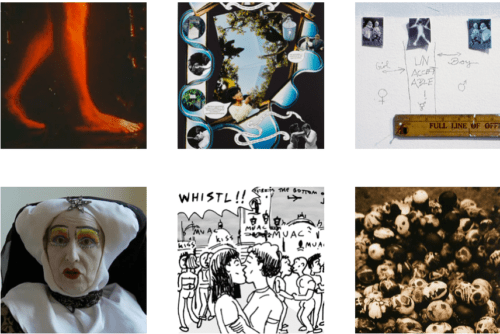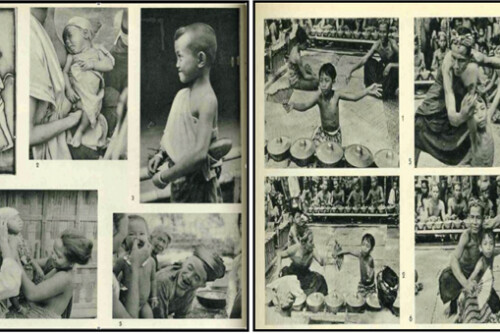The more fantastical and imaginary elements of Fig Trees includes and makes space for this adolescent fear and trauma of younger generations often left out in AIDS narratives, but who were and have been affected by HIV/AIDS in their own respective ways. In my case, by the time I got to New York, the glory days of ACT UP were well over. While I spent countless hours with friends a decade or so older listening to their depictions, memories, and mythologizing of the exciting time when gay men—radicalized—actually gave a damn (catching up with dykes who benefited from the historical purpose and affiliation with the feminist movement); New York City gay life, in contrast seemed dominated by quite another mentality. Having attained a certain level of success and survival, they desired, it seemed, a (largely imagined) return to “normality”: Wall Street job, gym/circuit party life; an apolitical, “leave me alone” attitude seemed to dominate. Understandable after the trauma of the AIDS scare, perhaps, but not very inspiring for budding queer radicals.1 In this sense, a film like Fig Trees provides important historical connection for younger activists, disconnected by time and place from important struggles and experiences missed. In retrospect, the global AIDS struggles of the Health Gap/TAC protests, with their critique of Intellectual Property Rights, hurled many of a younger generation of queer activists directly into the budding anti-globalization/global justice movement in Seattle and beyond.2 In creating a film to which multiple generations and different types of people affected by HIV/AIDS can relate, through its attention to the imaginary, Greyson succeeds in tightening social and communal bonds across age, race, gender, sexuality, nationality, and geography, without losing a distinctively queer perspective.
Moreover, in presenting these activists as postmodern-day saints whose struggles changed the world, rather than simply memorializing them, Fig Trees queers religion and its imagery in a very political way, helping reconfigure what it means to be a saint and sinner in the context of today’s struggles. For instance, while the current “It Gets Better” campaign admirably seeks to give hope to queer youth in the context of widespread bullying3 and homophobia, in relative contrast, Fig Trees highlights the necessity of engaging in active social struggle. In this sense, Greyson’s timely docu-opera sounds the call for renewed attention to contemporary struggles—struggles far from over given that HIV/AIDS drugs are far from universally available across the globe. Even in the United States—the supposed center of the developed world—the prevailing mood of Tea Party-imposed austerity augurs federal, state and local cutbacks to healthcare and increasing denial of services to those living with HIV/AIDS, a stark reversal from the optimism and hope for universal healthcare at the dawn of the Obama Administration only a short time ago. For instance, over 9,000 people in need of meds are currently on AIDS Drug Assistance Program (ADAP) waitlists in 13 states in the U.S. alone.4 While 34 million people around the globe are estimated to be living with HIV/AIDS, half of them do not know it. An estimated nine million of them are not getting the drugs they need, and 1.8 million people still die of AIDS each year alone.5 While real strides have been made in many ways, which Fig Trees celebrates, AIDS is still an epidemic troublingly far from over, as increasing numbers of people, particularly men and women of color and young gay men—and especially young gay men of color and men who have sex with men [MSM]—seroconvert at an alarming rate.6 Meanwhile, sex education and HIV/AIDS prevention funding is slashed, and the idea prevails that the threat of HIV/AIDS is largely over. It seems clear that the looming threat of austerity—”planned” or “managed” scarcity—as a solution to economic problems will likely be a central battleground for years to come.
All the more important then is the value that a critical and impassioned film like Fig Trees contributes to queer culture and the larger society, preserving the memory of previous struggles, while highlighting the lesson that it is struggle, often painful struggle, rather than the simple passage of time or “march of progress” that has changed the world. Like collage, Fig Trees cuts, combines, and preserves the trauma and traces of important queer historical memory and purpose, jettisoning any stale documentary-style recounting of the facts to get to the heart of the political and historical encounter the various AIDS protest movements embody. Utilizing parody, pastiche, and the healing power of music, Fig Trees intimates a refiguring of religion, body, memory, and struggle for all those affected by HIV/AIDS—a reconfiguring of saints and sinners for the “true religion” of queer historical memory.
- See Matilda Sycamore Bernstein, ed., That’s Revolting! Queer Strategies for Resisting Assimilation (New York: Soft Skull Press, 2004). [↩]
- See Benjamin Shepard and Ronald Hayduk, From ACT UP to WTO: Urban Protest and Community Building in the Era of Globalization (London: Verso, 2002). [↩]
- The Huffington Post, “Anoka-Hennepin, Minnesota School District, Faces Another Lawsuit Over Alleged Gay Bullying,”, 8 August 11, 2011. [↩]
- D. Gregory Smith, “ADAP Waitlist Passes 9,000,” The Bilerico Project, 16 August 2011. [↩]
- News From Africa, “Africa: Leaders Call for More AIDS funds at UN Summit“, 9 June 2011; UNAIDS Report on the Global AIDS Epidemic 2010. [↩]
- Rod McCullom, “AIDS 2010: Concerns for Black Gay and Bisexual Men Raised to National and Global Platforms,” The Body 21 July 2010. [↩]



